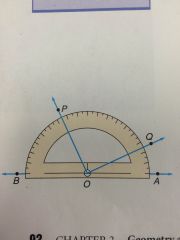![]()
![]()
![]()
Use LEFT and RIGHT arrow keys to navigate between flashcards;
Use UP and DOWN arrow keys to flip the card;
H to show hint;
A reads text to speech;
24 Cards in this Set
- Front
- Back
|
Postulate 1 UNIQUE LINE POSTULATE
|
Through two distinct points, there is exactly one line.
|
|
|
Postulate 2
|
A line contains at least two distinct points
|
|
|
Postulate 3 UNIQUE PLANE POSTULATE
|
Through three no collinear points, there is exactly one plane
|
|
|
Postulate 4
|
A plane contains at least three noncollinear points
|
|
|
Postulate 5
|
If two distinct points lie in a plane then the line joining them lies in that plane
|
|
|
Postulate 6
|
If two distinct planes intersect then their intersection is a line
|
|
|
Postulate 7
|
The points on a line can be paired, one-to-one, with the real numbers so that any point is paired with 0 and another point is paired with 1.
The real number that corresponds to a point is the coordinate of that point. The distance between two points on the line is equal to the absolute value of the difference of their coordinates. |
|
|
Postulate 8
|
If point c is between points a and b then ac+cb=ab
|
|
|
Postulate 7-ruler postulate
|
The points on a line can be paired, one-to-one, with the real numbers so that any point is paired with 0 and another point is paired with 1.
The real number that corresponds to a point is the coordinate of that point. The distance between two points on the line is equal to the absolute value of the difference of their coordinates. |
|
|
Postulate 8-segment addition postulate
|
If point c is between points a and b then ac+cb=ab
|
|
|
Postulate 9 Protractor postulate
|

Let O be on a point on line AB such that O is between A and B. Consider Ray OA, Ray OB and all the Rays that can be drawn from O on one side of line AB. These rays can be paired with the real numbers from 0 to 180 so that
1. Ray OA is paired with 0 and Ray OB is paired with 180. 2. If Ray OP is paired with x and Ray OQ is paired with y, then the number is paired with <POQ is |x-y|. This number is called the measure or the degree measure of <POQ. |
|
|
Angle addition postulate
|
If point B is in the interior of <AOC then the measure of <AOB + the measure of <BOC = the measure of <AOC
|
|
|
Linear pair postulate
|
If two angles form a linear pair, then they are supplementary.
|
|
|
Linear pair postulate
|
If two angles form a linear pair, then they are supplementary.
|
|
|
Opposite Rays
|
Ray BA and Ray BC are opposite Rays if point B is between points A and points C
|
|
|
Linear pair postulate
|
If two angles form a linear pair, then they are supplementary.
|
|
|
Opposite Rays
|
Ray BA and Ray BC are opposite Rays if point B is between points A and points C
|
|
|
Complementary angles
|
Two angles whose measures have a sum of 90 degrees
|
|
|
Supplementary angles
|
Two angles whose measures have a sum of 180 degrees
|
|
|
Adjacent angles
|
Two angles in the same plane that share a common side and common vertex
|
|
|
Adjacent angles
|
Two angles in the same plane that share a common side and common vertex
|
|
|
Linear pair
|
Two adjacent angles whose noncommon sides are opposite Rays
|
|
|
Congruent angles
|
Angles that are equal in measure
|
|
|
Angles bisector
|
The Ray that divides the angle into 2 congruent angles
|

